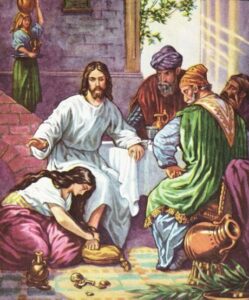
“Jesus was in Bethany at the home of Simon, a man who had previously had leprosy. While he was eating, a woman came in with A BEAUTIFUL ALABASTER SHE BROKE OPEN THE JAR AND POURED THE PERFUME OVER HIS HEAD jar of expensive perfume made from essence of nard. Some of those at the table were indignant. “Why waste such expensive perfume?” they asked. “It could have been sold FOR A YEAR’S WAGES and the money given to the poor!” So, they scolded her harshly. But Jesus replied, “Leave her alone. Why criticize her for DOING SUCH A GOOD THING TO ME? You will always have the poor among you, and you can help them whenever you want to. But you will not always have me. She has done what she could and HAS ANOINTED MY BODY FOR BURIAL AHEAD OF TIME. I tell you the truth, wherever the Good News is preached throughout the world, THIS WOMAN’S DEED WILL BE REMEMBERED AND DISCUSSED.” (Mark 14:3-9)
Alabaster is “a firm, very fine-grained, variety of gypsum”, used for statuary and as indoor decorative stone, especially for carved ornamental vases and figurines…The biblical terms translated alabaster…may also refer to marble, although alabaster probably entered Israel from Egypt much earlier than marble was imported from the Greek world. The disciples reveal to us that the ointment used was expensive, but we do not know its exact cost. What makes the ointment so special and why is it so valuable? The ointment came for Northern India and was made of PURE NARD. Pure Nard, also known as spikenard, is an aromatic amber-colored essential oil derived from the Nardostachys jatamansi plant. It grows in the Himalayas of Nepal, China, and India. In biblical times, nard was used for anointing and burial rituals. The worth of the ointment was about a years’ worth of wages. Nard is made from a plant that grows in the Himalayas and is used as ointment or perfume. The cost of the ointment was worth about 300 denarii, about $54,509 in U.S. dollars.
Your Personal Pastor -Bill Stockham